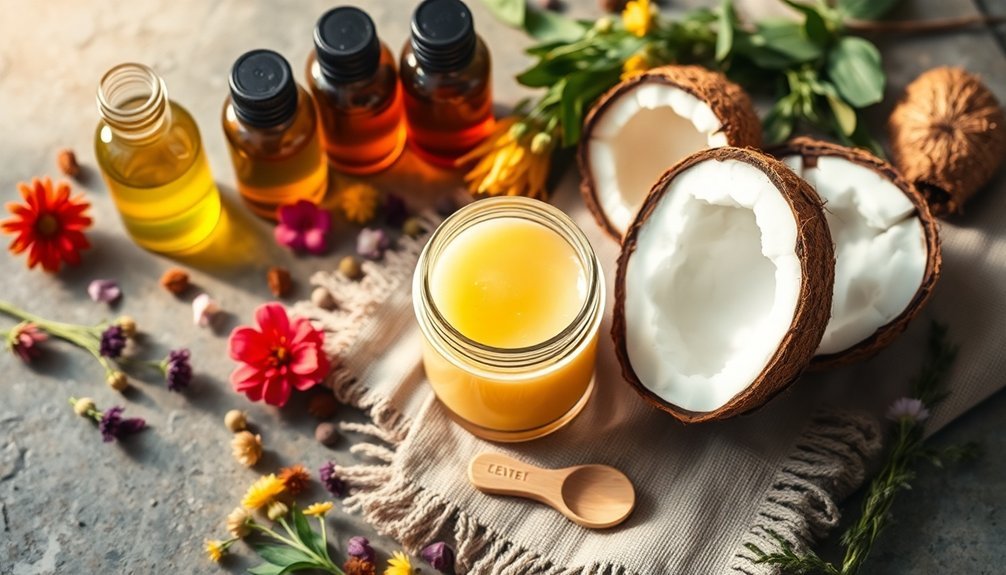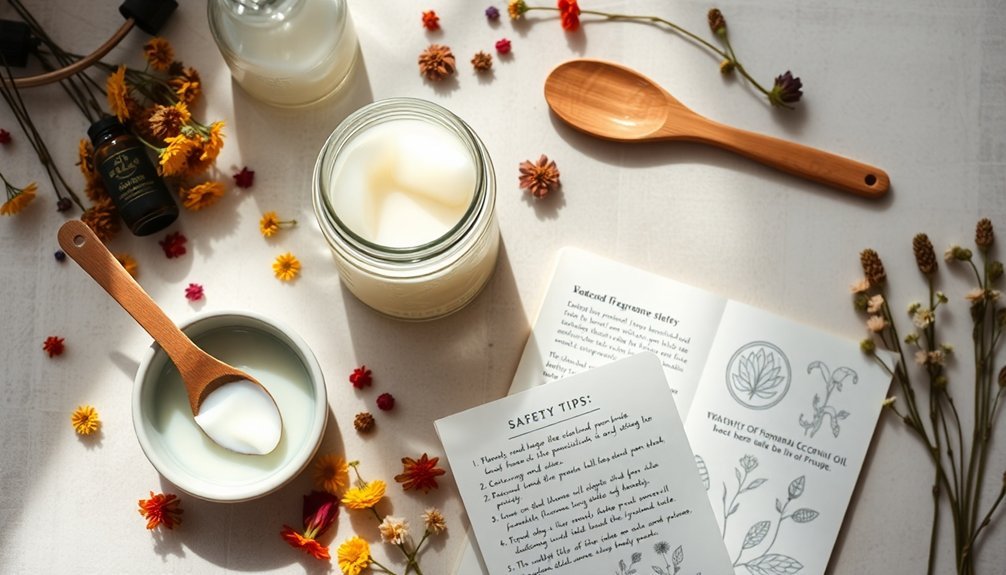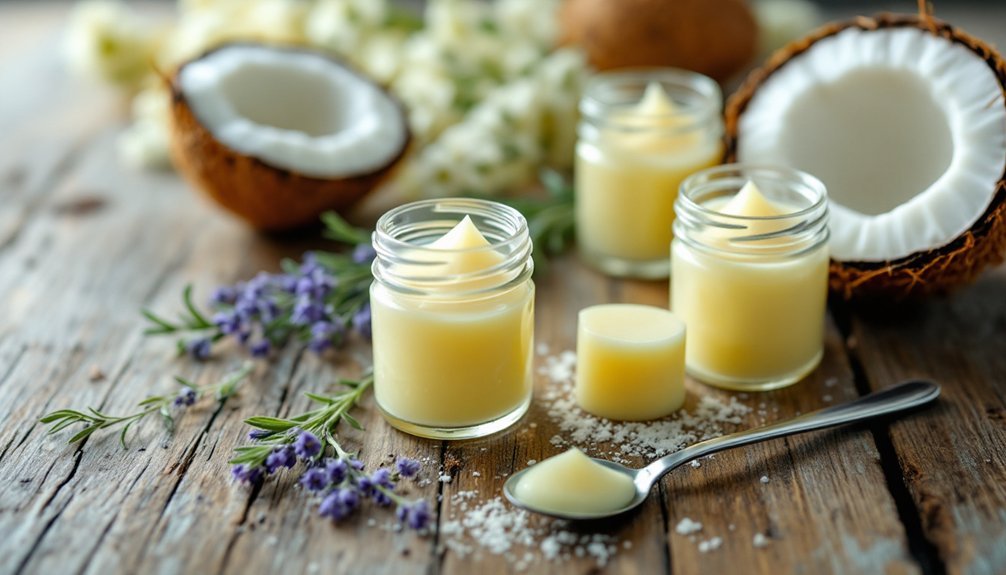You can make your own solid perfume with just three simple ingredients: beeswax, coconut oil, and essential oils. Start by melting equal parts beeswax and coconut oil in a double boiler, then remove from heat and add your favorite essential oils. Pour the mixture into small containers and let it cool completely. This natural, portable fragrance lasts longer than liquid perfumes and lets you create custom scents. The creative possibilities are endless when you explore essential oil combinations.
Why Make Your Own Solid Perfume at Home

While commercial perfumes flood the market with mass-produced scents, making your own solid perfume offers a uniquely rewarding experience.
You'll gain complete control over your signature fragrance while avoiding synthetic additives and common irritants that can harm sensitive skin.
Creating your own solid perfume isn't just about personalization – it's also practical and eco-friendly.
Solid perfumes offer a personal touch while delivering practical benefits and environmental consciousness in one compact, sustainable package.
You'll benefit from a portable, spill-proof format that's perfect for travel, and the solid base typically lasts longer than liquid alternatives. The natural ingredients provide moisturizing and nourishing benefits that enhance your skin's health.
Plus, you're making an environmentally conscious choice by reducing packaging waste and avoiding aerosol sprays.
The cost benefits are significant too.
Instead of purchasing multiple commercial perfumes, you can craft your perfect scent while saving money and using natural, skin-nourishing ingredients like coconut and jojoba oils.
Essential Materials and Tools You'll Need
Before starting your solid perfume-making journey, you'll need to gather specific materials and tools to guarantee success. The foundation of your solid perfume requires beeswax for solidification and a carrier oil like fractionated coconut oil or sweet almond oil for the base.
You'll also need essential oils to create your desired fragrance blend. Remember to select only pure essential oils without any synthetic additives or fillers.
For equipment, you'll want either a double boiler or microwave-safe bowl to melt your ingredients safely. Don't forget to have measuring cups on hand for precise portions, and prepare a suitable container or tin for the final product.
While optional, a thermometer can help you monitor temperatures for ideal texture. If you prefer vegan alternatives, consider substituting beeswax with candelilla or carnauba wax.
Step-by-Step Coconut Oil Perfume Recipe

You'll want to start by gathering your beeswax, fractionated coconut oil, essential oils, and clean containers for your homemade perfume. Since commercial perfumes often contain synthetic fragrances that can cause health and hormonal issues, it's important to use natural ingredients.
Begin the process by melting your beeswax in a double boiler, then mix in the coconut oil while maintaining a steady temperature to prevent solidification.
Once you've achieved a smooth mixture, add your chosen essential oils and quickly pour the blend into your prepared containers, allowing it to cool and set completely.
Gathering Your Essential Materials
Creating your own solid perfume starts with gathering four essential components: beeswax for structure, coconut oil (or another carrier oil) for texture, your chosen essential oils for fragrance, and the necessary tools for preparation.
| Essential Component | Purpose |
|---|---|
| Beeswax | Provides solid structure and stability |
| Carrier Oil | Delivers smooth texture and nourishment |
| Essential Oils | Creates your desired fragrance blend |
| Tools | Enables proper mixing and storage |
| Storage Containers | Preserves your finished product |
You'll need a double boiler or microwave-safe container for melting, a grater for the beeswax, and small containers for storage. When selecting essential oils, consider combining top notes (citrus), middle notes (floral), and base notes (woody) to create a balanced fragrance that lasts. Choose carrier oils like fractionated coconut oil, jojoba, or almond based on your skin's needs.
Melting and Mixing Process
The melting and mixing process forms the heart of crafting your solid perfume, requiring careful attention to temperature and timing.
You'll need to set up a double boiler and maintain medium heat to melt your chosen wax and coconut oil together, stirring regularly for even distribution.
- Combine equal parts wax and coconut oil in your double boiler, heating until fully melted and well-blended. Keep stirring to guarantee uniform consistency.
- Remove the mixture from heat once it's completely liquified. Let it cool slightly before adding your selected essential oils.
- Pour the mixture slowly into your container, being careful to avoid creating air bubbles.
Allow it to cool at room temperature until completely solid, and you'll have a smooth, ready-to-use solid perfume.
Pour and Set Instructions
Once your melted mixture reaches the right temperature, pouring and setting your solid perfume requires precise timing and careful attention to detail.
Pour the warm mixture immediately into your chosen small containers, filling them about 2/3 full. You'll want to work quickly using a pipette for precision, as the mixture can start solidifying fast.
Let your perfume cool uncovered at room temperature to avoid condensation. If you're in a hurry, you can place the containers in the freezer to speed up the process.
Wait until the mixture has completely hardened before sealing or using your perfume. For best results, store your solid perfume in a cool, dry place.
When you're ready to use it, simply rub a small amount onto your skin to release the fragrance.
Choosing and Blending Essential Oils

You'll need to understand the three essential oil categories – base, middle, and top notes – to create a balanced fragrance that lasts.
When mixing your oils, start with a 30% base note, 50% middle note, and 20% top note ratio to achieve a well-rounded scent.
Create your signature blend by experimenting with different combinations of oils within each category, always testing small amounts first to guarantee you love the result.
Understanding Oil Notes
Creating beautiful fragrances begins with understanding the intricate layers of scent notes in essential oils.
Think of these notes as a symphony, where each layer plays its unique role in your perfume's composition.
1. Top notes like citrus and light florals provide the initial burst of fragrance you'll smell first, lasting about 5-15 minutes.
You'll find bergamot, grapefruit, and lavender in this category.
2. Middle notes form your perfume's heart, emerging as top notes fade.
They're often floral and spicy, featuring oils like jasmine, neroli, and cinnamon.
3. Base notes bring depth and staying power to your blend.
You'll want to include rich scents like vanilla, patchouli, or sandalwood to create a lasting foundation for your perfume.
Mixing Ratios Matter
Now that you understand scent notes, let's focus on the art of blending them together. The success of your solid perfume depends on finding the right balance between different essential oils.
You'll want to follow the 30/50/20 rule as your starting point: 30% top notes, 50% middle notes, and 20% base notes for a well-rounded fragrance.
Alternatively, you can try the simpler 2:1:1 ratio – two parts base note to one part each of heart and head notes.
Remember, these aren't rigid rules. You'll need to adjust based on each oil's strength and your desired scent profile.
Before committing to your final blend, test small amounts on a fragrance strip or cotton ball. Let your mixture rest for 48 hours to allow the scent to mature properly.
Personal Scent Creation
Diving into personal scent creation starts with selecting the right essential oils for your signature fragrance. Choose high-quality, organic oils that come with transparent testing reports to guarantee both safety and authentic scents.
You'll want to experiment with different combinations of top, middle, and base notes to create a balanced blend that reflects your personality.
- Start with bright top notes like bergamot, orange, or lemon to create an initial impression.
- Layer in middle notes such as rose or geranium for depth and character.
- Anchor your blend with rich base notes like cedarwood or vanilla for lasting power.
Test your combinations in a diffuser first, keeping detailed notes of successful ratios.
Remember to stay within safe dilution limits, never exceeding 5% concentration when mixing with your carrier oils.
Safety Tips and Best Practices

While making your own solid perfume can be exciting, following proper safety guidelines is essential to guarantee a safe and enjoyable experience. Always use cosmetic-grade ingredients and keep essential oil concentrations below 2% to prevent skin irritation. Test new blends on a small patch of skin before full application.
| Safety Measure | Why It Matters | Key Action |
|---|---|---|
| Temperature Control | Prevents burning | Heat on medium |
| Proper Tools | Guarantees safety | Use glass/ceramic |
| Concentration | Prevents irritation | Stay under 2% |
When melting your ingredients, use heat-resistant containers and avoid overheating the mixture. Don't forget to label your containers with all ingredients used, and store them properly. If you're sharing your creations, include a complete list of ingredients so others can check for potential allergies.
Storage and Shelf Life Guide
Proper storage of your homemade solid perfume can extend its shelf life considerably and preserve its fragrance intensity. Store your creation in a small, dark-colored container with an airtight lid, and keep it in a cool, dark place away from direct sunlight and heat sources.
Keep your solid perfume fresh and potent by storing it in a dark, airtight container away from heat and sunlight.
Your solid perfume can last up to a year when stored correctly, though the essential oils may gradually lose some potency over time.
- Choose tin or compact containers that protect your perfume from light and heat exposure
- Keep your perfume at room temperature – there's no need for refrigeration, but avoid extreme temperatures that can melt or harden the mixture
- Handle your perfume with clean hands to prevent contamination, and always guarantee the lid is tightly sealed after each use
Creative Ways to Use Your Solid Perfume

Now that you've mastered storing your solid perfume, you'll find countless ways to incorporate this versatile creation into your daily routine.
Apply it to your pulse points for a subtle, long-lasting fragrance that's gentler than commercial perfumes. You can also run it through your hair for a pleasant scent throughout the day.
Get creative by adding your solid perfume to massage oils for aromatherapy benefits, or use it to freshen up fabrics and pet collars.
It's perfect for creating personalized gifts – package it in decorative tins or combine it with other handmade skincare products for a thoughtful present.
Try experimenting with different essential oil blends to create seasonal scents or mood-enhancing fragrances that match your preferences or those of your gift recipients.
Frequently Asked Questions
Can I Substitute Soy Wax for Beeswax in Solid Perfume Recipes?
Yes, you can substitute soy wax for beeswax in your perfumes, but you'll need to adjust the ratios since soy wax is softer. Expect a slightly different texture and consider using more soy wax for firmness.
How Do I Remove Solid Perfume Stains From Clothing?
You'll need to blot the stain with absorbent paper towels first. Then apply a mix of dish soap and cold water, gently dab the area, and wash normally. Don't use hot water or dryer.
Why Does My Solid Perfume Develop a Grainy Texture Over Time?
Your solid perfume's grainy texture is likely due to temperature fluctuations. When you expose it to repeated warming and cooling, the ingredients can crystallize. Proper storage and temperature control will help prevent this issue.
Can I Add Dried Flowers or Herbs to My Solid Perfume?
Yes, you can add dried flowers and herbs to your solid perfume, but it's best to infuse them in carrier oil first. Strain before mixing with wax to avoid a grainy texture in your final product.
Does Solid Perfume Travel Well on Airplanes Compared to Liquid Perfumes?
Yes, you'll find solid perfumes are ideal for air travel. They're not subject to TSA liquid restrictions, won't leak or break, and you can pack them in any bag without worrying about the 3-1-1 rule.





Leave a Reply